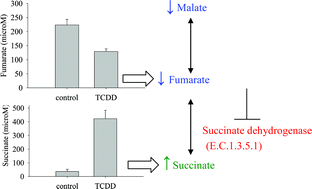Metabolomic analysis of liver and skeletal muscle tissues in C57BL/6J and DBA/2J mice exposed to 2,3,7,8-tetrachlorodibenzo-p-dioxin†
Abstract

* Corresponding authors
a
Department of Chemistry, Hong Kong Baptist University, Hong Kong SAR, China
E-mail:
zwcai@hkbu.edu.hk
Fax: +852-3411 7348
Tel: +852-3411 7070
b Department of Physics, Hong Kong Baptist University, Hong Kong SAR, China
c State Key Laboratory of Bioelectronics, Southeast University, Nanjing, China

 Please wait while we load your content...
Something went wrong. Try again?
Please wait while we load your content...
Something went wrong. Try again?
S. Lin, Z. Yang, H. Liu and Z. Cai, Mol. BioSyst., 2011, 7, 1956 DOI: 10.1039/C1MB05057E
To request permission to reproduce material from this article, please go to the Copyright Clearance Center request page.
If you are an author contributing to an RSC publication, you do not need to request permission provided correct acknowledgement is given.
If you are the author of this article, you do not need to request permission to reproduce figures and diagrams provided correct acknowledgement is given. If you want to reproduce the whole article in a third-party publication (excluding your thesis/dissertation for which permission is not required) please go to the Copyright Clearance Center request page.
Read more about how to correctly acknowledge RSC content.
 Fetching data from CrossRef.
Fetching data from CrossRef.
This may take some time to load.
Loading related content
